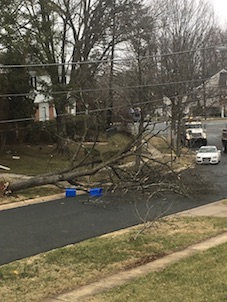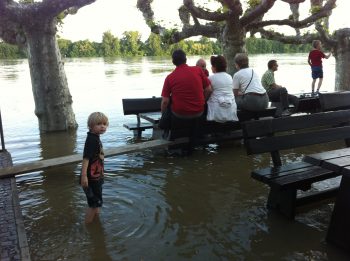
Weather in the US is a never-ending source of surprise. Due to the sheer size of the country, hurricanes, blizzards, tornadoes, and earthquakes aren’t anything uncommon. The moderate climate in France and the continental weather in Germany are more predictable than US weather.
I don’t know how many of my American readers have subscribed to free weather warning texts, but I can assure you that the probability of extreme weather in France or Germany is so minimal that we don’t need this service. We rely on the weather segment of the news on TV or the radio, or even good old word of mouth to know when bad weather is coming. My choice of words is also telling—bad weather, not severe weather!
I confess that I’m a big fan of disaster movies. From The Day After Tomorrow to trashy B-movies, I have seen a lot of them. But my passion is particularly intense for movies with extreme nature phenomena that threaten the world (like 2012), or at least a city (Volcano). Well, living in the United States gives me enough of that. I haven’t experienced them all myself, but I’ve run into enough to report that they’re more fun in a movie than in real life!
Yes, the weather is a never-ending source of surprise in the United States, at least when you’ve moved from a more temperate climate zone.
Weather phenomena in my American life
In an older post, I republished this map that I found in several blogs and articles from all over the web (it’s hard to attribute it to the right person, but I believe it’s the work of an economist named Max Roser). Geographically, Europe is farther north than the most of the United States. New York is in line with Madrid, the capital of Spain, while Paris is at the same latitude as Toronto. Snow in Madrid or Paris? Children run eagerly after a few snowflakes that won’t even stay on the boardwalks!

In January 2016, a blizzard hit the American Mid-Atlantic Region. In Montgomery County, it started to snow on Friday at noon and stopped 36 hours later, leaving 2.5 feet of snow in our driveway. We were stuck at home for 5 days, waiting for the snow plow to come and clear the street. Schools in our county were closed for 6 days.
A few weeks ago, I received several text warnings about an imminent tornado. A tornado near the capital? Don’t tornadoes stick to the Midwest, Great Plains, etc.? Has Tornado Alley moved further east? We ended up with a tremendous thunderstorm, water rivers forming on main streets, along with the most threatening sky I’d ever seen in my life.
It doesn’t matter that the tornado didn’t touch down this time. During thunderstorms, trees regularly crashed on streets, cars, and houses. The pictures below were all shot in my neighborhood.
Over Memorial Day Weekend, after a severe thunderstorm, flash floods struck the little town of Ellicott City, about one hour away from my home. According to USA Today, “the second “1-in-1,000 year rain event” in two years sent floodwaters roaring down Main Street in historic downtown Ellicott City.”
Now, compare this storm with what happened at the same time in Wuppertal, Germany. The weather may have been impressive from a German perspective, but the fountain you can see occurred after an underground pipe overflowed with water, pushing the sewer lid out of its housing. Still, Wuppertal is a large city and the flooding wasn’t half bad as it was in Ellicott City.
Which brings me to today’s question:
Why is life in the US so much more affected by weather than life in Europe?
Even though Europe and the United States are about the same size, the US is about 15 times bigger than France and 28 times bigger than Germany. It takes 4.5 hours to fly from New York to Los Angeles, but in the same amount of time, I could travel from Paris to Jerusalem, or from Berlin to Baghdad.
The United States has so many climate types that I can’t list all of them! In comparison, France and Germany are really boring with a similar climate across the whole country: moderate in France, continental in Germany.
With that said, the variety of climates in the US doesn’t explain why weather affects the lives of American citizens so greatly. Neither does their geographic location.
Are American houses made of cards?
Before I lived in this country, of course I knew of the devastating effects of hurricanes and tornadoes. European media are not immune to hurricane hype, and thanks to TV footage French and German people have seen homes torn down like a house of cards.
Until recently, I didn’t think for a second about the construction of American homes. I genuinely thought that they were built like those in Europe, with bricks and mortar.
Then, I discovered that even “brick” houses in the US are built around a wooden structure. In my neighborhood, as I talked about in last week’s post, old houses are being torn down and replaced by large 5-bedroom homes. It takes less than a day to bulldoze the old one and only 3 or 4 months to build a new one… out of wooden beams and plywood.
I’ve frequently heard from European expats that “Americans don’t know how to build anytime solid” or that “Land-use planning here is a joke.” Is making money more important than protecting lives from weather hazards?
But, how do my fellow expats know that a house made of brick and concrete could withstand a tornado?
Germany is hit by around 60 tornadoes each year. On May 16, an F2 tornado touched down on the German city of Viersen. According to several German media outlets, around 40 to 50 homes were damaged during the storm. However, these consequences are barely comparable with the damages caused by a tornado in the US. Not a single home was tossed in the air and damage was limited to a few missing roof tiles blown away by the wind.
Severe weather in Europe can be nasty too
My daughter Jasmine was born during the 1999 winter storm which caused 140 fatalities in Europe. In 2010, cyclone Xynthia caused the death of 53 people in France and 6 in Germany. At the beginning of 2018, cyclone Friederike affected most parts of Europe, killing 13 people.
Again, however the wind damage in Europe just isn’t comparable with the US. French or German houses are much sturdier, meaning a brick wall is a brick wall, unlike my American house which appears to have a brick wall, when in reality, the bricks are just piled and mortared on top of a classic wooden structure.
Of course, heavy rain and melting snow can cause flooding and landslides in Germany and France. But, flash flooding is rarer.
The 2003 European heat wave
The summer of 2003 was the hottest in Europe since the 16th century (Source: Word Meteorological Organization) and “peer-reviewed analysis places the European death toll at more than 70,000.” France was hit particularly hard. According to the French National Institute of Health, 15,000 casualties were heat related. Most of them were elderly people living alone, without frequent contact with their family. The catastrophe happened in August, a month when many people are on vacation.
In this post from 2016, I’ve explained how Europeans can live without air conditioning and I’ve pointed out that since its use in the United States has become widespread, the number of heat wave-related deaths has dropped dramatically. Unfortunately, only 5% of French homes are equipped with air conditioning .
Weather in the US is a never-ending source of surprise, but but at least Americans know how to manage a heat wave. A/C could’ve saved many lives in Europe.











